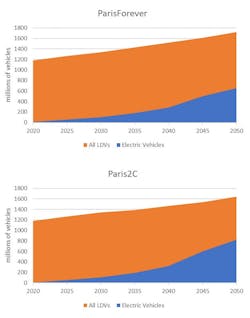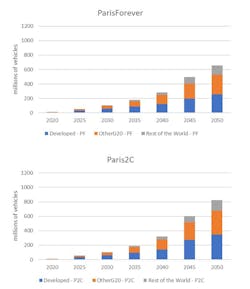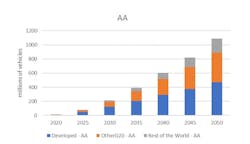Electrification of Light-Duty Vehicles: A Partial Solution for Decarbonization
Among the research findings presented in the 2021 Global Change Outlook by MIT Joint Program on the Science and Policy of Global Change, released in May 2021, is a study focused on electric vehicles (EVs) as a partial solution for decarbonizing the transportation sector.
The Outlook is based on rigorous, integrated analysis of population and economic growth, technological change, Nationally Determined Contributions (NDCs) to the Paris Agreement, Covid-19 impacts and other factors. It presents the Joint Program’s latest projections for the future of the Earth’s energy, food, water and climate systems, as well as prospects for achieving the Paris Agreement’s short and long-term climate goals.
Projections are provided for a baseline Paris Forever scenario, in which current (as of March 2021) NDCs are maintained in perpetuity; a Paris 2°C scenario that caps global warming at 2°C by 2100; and an Accelerated Actions scenario, which limits warming to 1.5°C by 2100. More precise scenario definitions are provided in the report, which also introduces a visualization tool that enables a higher-resolution exploration of each scenario.
Reproduced here in its entirety, the study shows that while electrification of light-duty vehicles can contribute significantly to mitigating greenhouse gas emissions in the transportation sector, a more comprehensive approach is needed to complete the job.
Context
EVs offer a solution for decarbonizing the transportation sector. Household private light-duty (i.e., cars and light trucks) vehicles (LDVs) are well-suited for electrification because of their smaller size and battery requirements compared with commercial vehicles that transport heavier loads. And as the electricity sector turns increasingly to clean energy sources, EVs will help to reduce both GHG emissions and air pollution. Several car manufacturers and local and regional governments have declared ambitious targets for EV deployment in the next 10-15 years, but achieving LDV decarbonization on a large scale will be a formidable task.
In the MIT Mobility of Future study (MIT, 2019), we helped quantify the size of the current global LDV fleet (1.1 billion vehicles) and future scenarios for its growth. Currently, the EV fleet (battery-electric and plug-in-hybrid vehicles) is rather small, with about 10 million vehicles at the end of 2020 — less than 1% of the total LDV fleet. Last year EV sales set a new record with about 3 million vehicles sold globally (see Box A for an assessment of the pandemic’s impact on EV sales). With annual global LDV sales of about 100 million vehicles, substantial expansion of EVs will be needed to achieve decarbonization goals.
Key Findings
We estimate a rapid increase in global EV stock over the next three decades. From about 10 million in 2020, the EV stock in the Paris Forever scenario will reach 100 million in 2030 (Figure 1, top), almost 300 million in 2040 and nearly 650 million in 2050. With LDV stock increasing overall from 1.1 billion in 2020 to about 1.7 billion in 2050, the EV share of the LDV fleet will reach 38% in 2050. The EV growth is even faster in the Paris 2°C scenario, with a projected 825 million EVs on the road by 2050 (Figure 1, middle), with 50% of the LDV fleet electric. To achieve this level of EV fleet penetration, 80% of all cars sold globally in 2050 must be electric. For additional details about these scenarios, see MIT (2019).We also explore a scenario with more aggressive global mitigation actions, including accelerated support for EVs. In this scenario, the EV stock will reach more than 200 million vehicles in 2030, 600 million in 2040 and more than 1 billion in 2050 (Figure 1, bottom). If we assume this accelerated deployment of EVs, two-thirds of all global LDVs by 2050 will be electric. Our modeling implies that to achieve a 67% electrification of the global LDV stock, global EV sales would exceed 30 million in 2030, 60 million in 2040 and 100 million in 2050. While we have not evaluated the amount and availability of materials needed for battery production to support these levels of car manufacturing, it is clear that new supply chains and technologies will be critical for sustained growth in EV deployment.
Our projections of EV deployment by major regional groupings (Figure 2) show that the growth will be led by the developed (driven by Europe and the United States) and other G20 (driven by China and India) regions. We estimate that in 2030, the developed region will have the most EVs (about 60 million vehicles in Paris Forever and Paris 2°C scenarios and about 120 million vehicles in the Accelerated Actions scenario), but by 2050, the EV markets in the developed and other G20 regions will roughly be of the same size (260-270 million vehicles in the Paris Forever, 330-350 million in the Paris 2°C and 425-465 million in the Accelerated Actions scenarios) because other countries in the other G20 region (Mexico, Brazil, Russia, Korea, Indonesia) are also projected to substantially accelerate their electrification efforts by midcentury.
The leaders in EV deployment in all scenarios are China, Europe and the United States (Figure 3). In the Paris Forever scenario, we estimate that China’s electric fleet will grow from 4.5 million in 2020 to about 25 million in 2030 and to about 130 million in 2050. In the Accelerated Actions scenario, China’s EV stock will reach 50 million in 2030 and 250 million in 2050. Europe will have comparable growth till 2030 (from the current 2.4 million EVs in 2020) but will then grow slower than China. Europe’s EV fleet in 2050 will be about 100 million in the Paris Forever scenario and about 200 million in the Accelerated Actions scenario. The EV deployment trajectory in the United States will be similar to Europe’s. India’s LDV fleet is projected to be smaller than in China, Europe or the United States but its EV growth is also remarkable, reaching about 50 to 60 million EVs by 2050.
Implications
The electrification of LDVs will grow rapidly in all scenarios. By midcentury, EVs will occupy a large share of the fleets in all world regions with major market growth in China, Europe and the United States. Meanwhile, the need for mobility expands substantially. While the electrification of LDVs can contribute significantly to mitigating GHG emissions in the transportation sector, it offers only a partial solution. A comprehensive solution will require not just one technology but an integrated system approach that includes more efficient internal-combustion vehicles, a long-term switch to low- and net-zero carbon fuels for transport, and increased efficiency of the transport system through digitalization, smart pricing and multi-modal integration. Additional emissions reductions could come from more consumers shifting from private transportation to low-emitting public transport, shared mobility, biking and walking.
References
MIT Mobility of Future study (MIT, 2019)
About the Author
Sergey Paltsev
Dr.
Dr. Sergey Paltsev is a Deputy Director of the MIT Joint Program on the Science and Policy of Global Change, a Senior Research Scientist at the MIT Energy Initiative and MIT Center for Energy and Environmental Policy Research (CEEPR), and a Director of the MIT Energy-at-Scale Center, Massachusetts Institute of Technology (MIT), Cambridge, USA.
Dr. Paltsev is the lead modeler in charge of the MIT Economic Projection and Policy Analysis (EPPA) model of the world economy. His research covers a wide range of topics, including energy economics, climate policy, taxation, advanced energy technologies and international trade. Sergey is an Advisory Board Member for the Global Trade Analysis Project (GTAP) Consortium and a Member of the Economy-Wide Modeling Panel for the US Environmental Protection Agency (EPA) Science Advisory Board. Dr. Paltsev is an author of more than 100 peer-reviewed publications in scientific journals and books.
He is a recipient of the 2012 Pyke Johnson Award (by the Transportation Research Board of the National Academies, USA, for the best paper in the area of planning and environment), the Best Policy Analysis Paper of 2012 by Environmental Science and Technology Journal of the American Chemical Society and the Best 2004 Research Award by Tokyo Electric Power Company, Japan.
Sergey was a Lead Author of the Fifth Assessment Report (AR5) of the Intergovernmental Panel on Climate Change (IPCC). In 2007-2008, Dr. Paltsev was a member of the Expert Panel on the Economics of Climate Change for the U.S. Government Accountability Office (GAO).
Before joining MIT in 2002, Sergey Paltsev worked as a Consultant for International Management and Communication Corporation and The World Bank, and as an Executive Director of the Program in Economics and Management of Technology at Belarusian State University. He received a Diploma in Radiophysics and Electronics from Belarusian State University and PhD in Economics from University of Colorado at Boulder.





